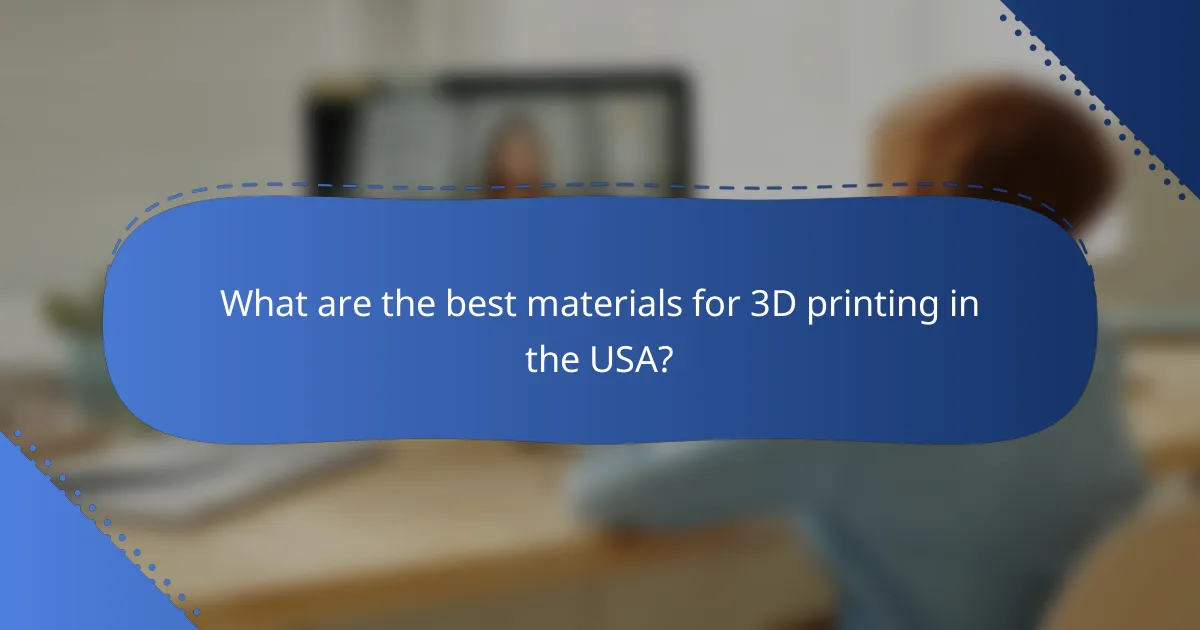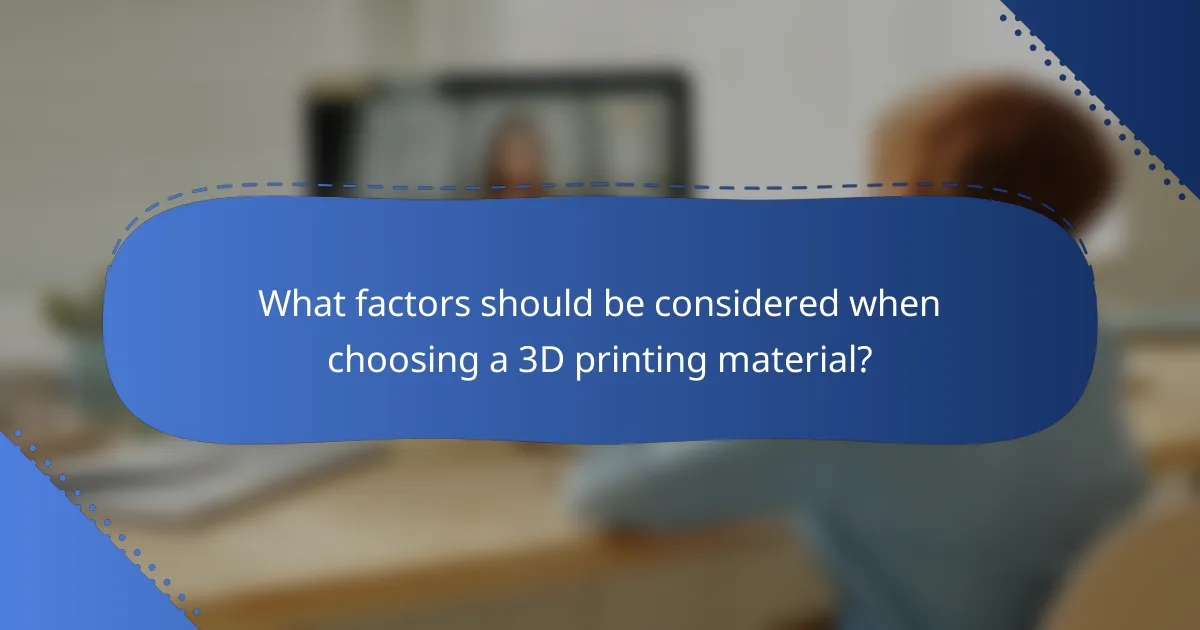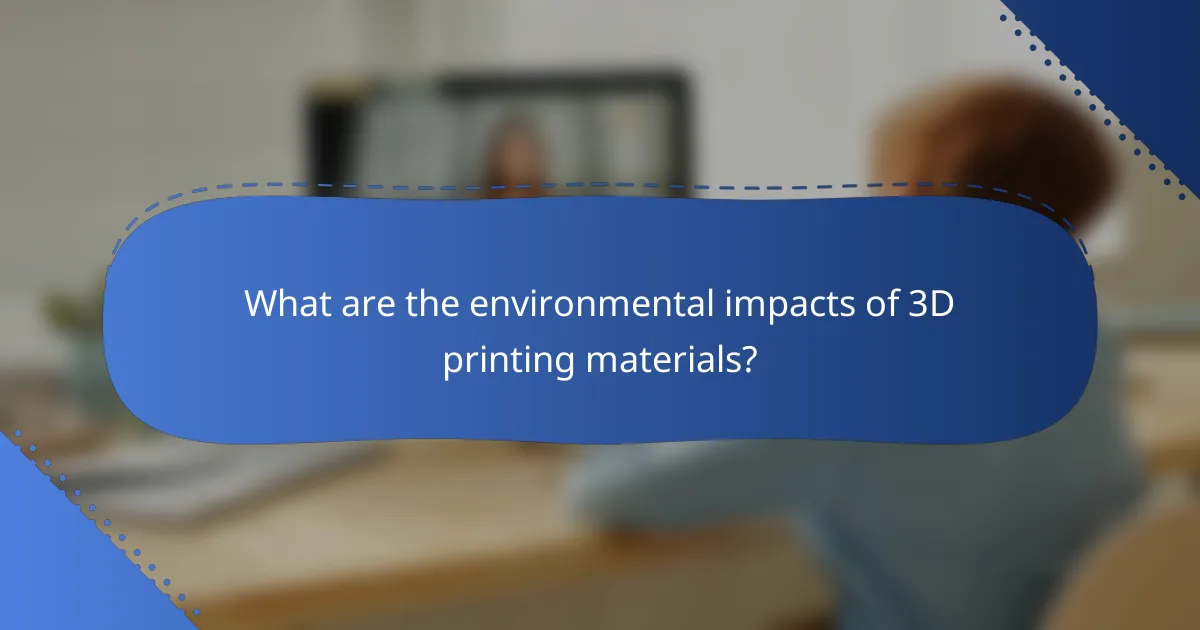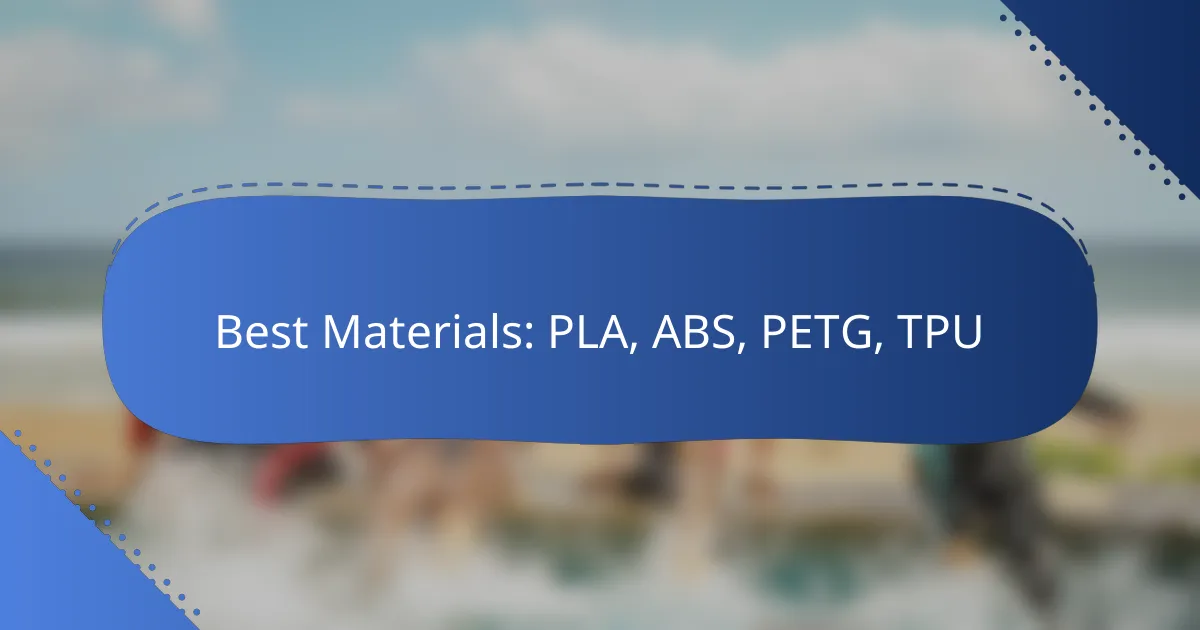When it comes to 3D printing, choosing the right material is crucial for achieving the desired results. PLA, ABS, PETG, and TPU each offer unique characteristics that cater to various applications, from prototypes to functional parts. By understanding their properties, you can make informed decisions that enhance your projects’ quality and performance.

What are the best materials for 3D printing in the USA?
The best materials for 3D printing in the USA include PLA, ABS, PETG, and TPU, each offering unique properties suited for different applications. Selecting the right material depends on factors such as ease of use, durability, flexibility, and elasticity.
PLA for ease of use
PLA (Polylactic Acid) is widely regarded as the most user-friendly 3D printing material. It is biodegradable, made from renewable resources like corn starch, and adheres well to the print bed, reducing the chances of warping.
This material is ideal for beginners and is commonly used for prototypes, toys, and decorative items. It prints at lower temperatures, typically around 180-220°C, making it compatible with most standard 3D printers.
ABS for durability
ABS (Acrylonitrile Butadiene Styrene) is known for its strength and toughness, making it suitable for functional parts and prototypes that require durability. It can withstand higher temperatures compared to PLA, with a typical printing range of 220-260°C.
However, ABS can be more challenging to print due to its tendency to warp and emit fumes. Using an enclosed printer and a heated bed can help mitigate these issues, ensuring better adhesion and reducing warping.
PETG for strength and flexibility
PETG (Polyethylene Terephthalate Glycol) combines the best features of PLA and ABS, offering both strength and flexibility. It is resistant to impact and moisture, making it suitable for functional parts that may be exposed to various conditions.
Printing PETG typically occurs at temperatures between 220-250°C. It adheres well to the print bed and has less warping than ABS, making it a good choice for both beginners and experienced users looking for reliable performance.
TPU for elasticity
TPU (Thermoplastic Polyurethane) is a flexible material known for its elasticity and rubber-like properties. This makes it ideal for applications requiring bending, stretching, or compression, such as phone cases, gaskets, and custom footwear.
Printing with TPU requires a slower speed and careful calibration, typically at temperatures around 210-230°C. It is essential to use a direct drive extruder for optimal results, as this helps manage the material’s flexibility during the printing process.

How do PLA, ABS, PETG, and TPU compare?
PLA, ABS, PETG, and TPU are popular 3D printing materials, each with distinct properties and applications. Understanding their differences helps in selecting the right material for specific projects, considering factors like strength, flexibility, and ease of use.
PLA vs ABS: pros and cons
PLA (Polylactic Acid) is known for its ease of use and biodegradability, making it a great choice for beginners. It adheres well to the print bed and produces minimal warping, but it may not withstand high temperatures or mechanical stress.
ABS (Acrylonitrile Butadiene Styrene) offers greater strength and heat resistance compared to PLA, making it suitable for functional parts. However, it can be more challenging to print due to warping and requires a heated bed for optimal results. Consider your project’s requirements when choosing between these two materials.
PETG vs TPU: material characteristics
PETG (Polyethylene Terephthalate Glycol) combines the best features of PLA and ABS, offering good strength, flexibility, and chemical resistance. It is less prone to warping and can be printed without a heated bed, making it user-friendly for various applications.
TPU (Thermoplastic Polyurethane) is a flexible material known for its rubber-like properties. It is ideal for applications requiring elasticity and impact resistance, such as phone cases or wearables. However, printing with TPU can be tricky due to its tendency to string and require precise settings for best results.

What are the applications of PLA, ABS, PETG, and TPU?
PLA, ABS, PETG, and TPU are widely used materials in 3D printing, each suited for specific applications. Understanding their properties helps in selecting the right material for your project, whether for prototypes, functional parts, or flexible designs.
PLA for prototypes and models
PLA is an ideal choice for creating prototypes and models due to its ease of use and excellent print quality. It adheres well to the print bed and is available in a variety of colors, making it visually appealing for presentation purposes.
When using PLA, consider its lower heat resistance, which makes it unsuitable for high-temperature applications. However, it is biodegradable, making it an environmentally friendly option for temporary models.
ABS for functional parts
ABS is favored for producing functional parts because of its strength and durability. It can withstand higher temperatures and is more impact-resistant than PLA, making it suitable for mechanical components and everyday items.
Keep in mind that ABS requires a heated bed to prevent warping during printing. Proper ventilation is also necessary, as it emits fumes that can be unpleasant. For best results, use an enclosure to maintain a stable temperature throughout the printing process.
PETG for mechanical components
PETG combines the best features of PLA and ABS, offering strength, flexibility, and chemical resistance. It is ideal for mechanical components that require durability and the ability to withstand stress without breaking.
This material is easier to print than ABS and does not emit harmful fumes, making it a safer choice for indoor printing. However, it can be prone to stringing, so fine-tuning your printer settings is essential for achieving clean results.
TPU for flexible designs
TPU is a flexible filament that is perfect for designs requiring elasticity, such as phone cases, gaskets, and wearable items. Its rubber-like properties allow it to bend and stretch without losing shape, making it highly versatile.
When printing with TPU, use a slower print speed and ensure your printer is compatible with flexible materials. Proper bed adhesion is crucial to prevent warping, so consider using a textured surface or adhesive to enhance grip during printing.

What factors should be considered when choosing a 3D printing material?
When selecting a 3D printing material, consider printability, mechanical properties, and cost. Each factor significantly influences the success of your project and the final product’s performance.
Printability and ease of use
Printability refers to how easily a material can be processed in a 3D printer. Materials like PLA are known for their user-friendly nature, making them ideal for beginners due to their low warping and good adhesion. In contrast, materials like ABS may require more advanced settings and a heated bed to prevent issues.
Consider the printer’s capabilities as well; some materials may need specific nozzle temperatures or bed surfaces. Always check compatibility with your printer model to avoid frustrating print failures.
Mechanical properties
Mechanical properties include strength, flexibility, and durability, which are crucial for the intended application. For instance, ABS offers higher impact resistance compared to PLA, making it suitable for functional parts. On the other hand, TPU is a flexible material ideal for applications requiring elasticity.
Evaluate the specific requirements of your project. If you need a rigid part, opt for materials like PETG or ABS, while flexible applications will benefit from TPU. Understanding these properties helps in making informed choices based on performance needs.
Cost and availability
Cost and availability can vary widely among 3D printing materials. PLA is generally the most affordable and widely available, often costing between $20 to $30 per kilogram. ABS and PETG are typically in a similar price range but may be slightly more expensive depending on the supplier.
Check local suppliers for stock levels and prices, as availability can fluctuate. If you’re working on a budget, consider bulk purchasing or sourcing from local distributors to reduce shipping costs and ensure timely access to materials.

What are the environmental impacts of 3D printing materials?
The environmental impacts of 3D printing materials vary significantly based on the type of filament used. Materials like PLA are often considered more eco-friendly due to their biodegradable properties, while others like ABS and PETG have more concerning environmental footprints due to their petroleum-based origins.
PLA biodegradability
PLA, or polylactic acid, is derived from renewable resources such as corn starch or sugarcane, making it a biodegradable option for 3D printing. Under industrial composting conditions, PLA can decompose within a few months, significantly reducing its long-term environmental impact compared to traditional plastics.
However, for PLA to biodegrade effectively, it requires specific conditions such as high temperatures and humidity, which are typically found in industrial composting facilities. In home composting or landfill environments, PLA may take much longer to break down, sometimes years.
When considering PLA for 3D printing, it’s essential to check local waste management policies regarding composting and recycling. While PLA is more sustainable, its disposal methods can vary, so understanding local regulations can help maximize its environmental benefits.
